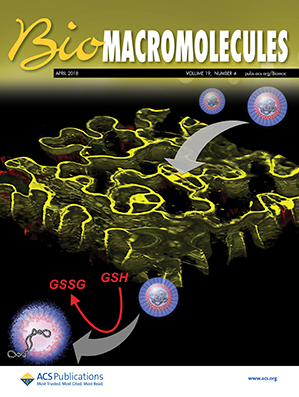开发用于治疗脑囊动脉瘤的可注射 ECM 衍生物栓塞剂。
IF 5.4
2区 化学
Q1 BIOCHEMISTRY & MOLECULAR BIOLOGY
引用次数: 0
摘要
脑动脉瘤是神经系统发病和死亡的根源,最常见的原因是动脉瘤破裂。治疗动脉瘤最常用的方法是使用铂金线圈等非生物降解医疗器械进行血管内栓塞。然而,由于线圈治疗后的动脉瘤会再堵塞,因此需要进行再治疗,这凸显了探索替代解决方案的重要性。在这项研究中,我们提出了一种可注射的细胞外基质衍生栓塞材料,它是通过迈克尔添加明胶-硫醇(Gel-SH)和透明质酸乙烯基砜(HA-VS)在原位形成的,可与治疗剂(此处为 RADA-SP)一起输送,以填充和重塑动脉瘤组织,而不会留下永久性异物。这种可注射的栓塞材料在生理条件下迅速凝胶化,形成高多孔结构并允许细胞浸润。这种可注射栓塞材料在体外的血栓形成行为与海藻酸注射材料相当。此外,在小鼠颈动脉瘤模型中进行的体内研究表明,3 周后,无论是否加入 RADA-SP,都能成功栓塞囊状动脉瘤并实现广泛的细胞浸润。结果表明,所开发的栓塞剂具有急性填充脑血管动脉瘤和促进稳定、慢性重塑所需的细胞浸润的内在潜力。本文章由计算机程序翻译,如有差异,请以英文原文为准。

Development of an Injectable, ECM-Derivative Embolic for the Treatment of Cerebral Saccular Aneurysms
Cerebral aneurysms are a source of neurological morbidity and mortality, most often as a result of rupture. The most common approach for treating aneurysms involves endovascular embolization using nonbiodegradable medical devices, such as platinum coils. However, the need for retreatment due to the recanalization of coil-treated aneurysms highlights the importance of exploring alternative solutions. In this study, we propose an injectable extracellular matrix-derived embolic formed in situ by Michael addition of gelatin-thiol (Gel-SH) and hyaluronic acid vinyl sulfone (HA-VS) that may be delivered with a therapeutic agent (here, RADA-SP) to fill and remodel aneurysmal tissue without leaving behind permanent foreign bodies. The injectable embolic material demonstrated rapid gelation under physiological conditions, forming a highly porous structure and allowing for cellular infiltration. The injectable embolic exhibited thrombogenic behavior in vitro that was comparable to that of alginate injectables. Furthermore, in vivo studies in a murine carotid aneurysm model demonstrated the successful embolization of a saccular aneurysm and extensive cellular infiltration both with and without RADA-SP at 3 weeks, with some evidence of increased vascular or fibrosis markers with RADA-SP incorporation. The results indicate that the developed embolic has inherent potential for acutely filling cerebrovascular aneurysms and encouraging the cellular infiltration that would be necessary for stable, chronic remodeling.
- Download: Download high-res image (50KB)
- Download: Download full-size image
求助全文
通过发布文献求助,成功后即可免费获取论文全文。
去求助
来源期刊

Biomacromolecules
化学-高分子科学
CiteScore
10.60
自引率
4.80%
发文量
417
审稿时长
1.6 months
期刊介绍:
Biomacromolecules is a leading forum for the dissemination of cutting-edge research at the interface of polymer science and biology. Submissions to Biomacromolecules should contain strong elements of innovation in terms of macromolecular design, synthesis and characterization, or in the application of polymer materials to biology and medicine.
Topics covered by Biomacromolecules include, but are not exclusively limited to: sustainable polymers, polymers based on natural and renewable resources, degradable polymers, polymer conjugates, polymeric drugs, polymers in biocatalysis, biomacromolecular assembly, biomimetic polymers, polymer-biomineral hybrids, biomimetic-polymer processing, polymer recycling, bioactive polymer surfaces, original polymer design for biomedical applications such as immunotherapy, drug delivery, gene delivery, antimicrobial applications, diagnostic imaging and biosensing, polymers in tissue engineering and regenerative medicine, polymeric scaffolds and hydrogels for cell culture and delivery.
 求助内容:
求助内容: 应助结果提醒方式:
应助结果提醒方式:


